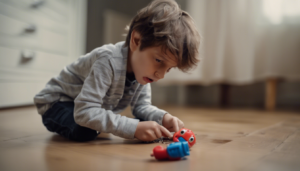Establishing routines can be instrumental for children with ADHD, helping them feel more in control of their daily lives. Many parents find that structured days make it easier for their children to focus, stay organized, and manage expectations. While ADHD in children presents unique challenges, simple adjustments, like incorporating predictable routines, can have a positive impact.
What Is ADHD?
ADHD stands for attention-deficit/hyperactivity disorder. It is a neurodevelopmental condition that affects how the brain regulates attention, behavior, and impulse control. Children with ADHD may find it difficult to concentrate, stay on task, or remember instructions.
ADHD is classified into three types: inattentive, hyperactive-impulsive, and combined. Inattentive ADHD involves trouble focusing and staying organized, often without hyperactivity. Hyperactive-impulsive ADHD includes excessive energy and impulsive behaviors like fidgeting or interrupting. Combined ADHD features symptoms of both, affecting focus, energy, and impulse control. Understanding the type is key to providing effective support.
ADHD in children is not a limitation of intelligence or capability. It is a condition linked to how the brain processes information and stimuli. Children with ADHD are just as capable as their peers but may require additional guidance to develop certain skills. This condition can affect areas of life including school performance, home routines, and social interactions.
What Are Its Causes and Symptoms?
The exact causes of ADHD are not fully understood. Research suggests it results from a combination of genetic, neurological, and environmental factors. Family history plays a role, as ADHD often runs in families. Differences in how the brain processes certain chemicals are also thought to contribute.
Symptoms of ADHD often include difficulty maintaining attention, a tendency to daydream, impulsivity, and struggles with organization. Children may also frequently forget things, switch between tasks without completing them, or display hyperactivity, such as an inability to sit still. These behaviors can impact performance at school and in social settings.
ADHD manifests differently in every child. Some may exhibit primarily inattentive behaviors, while others may display hyperactive and impulsive tendencies, or a mixture of both. Understanding these symptoms is key to supporting children effectively.
How Can Routines Help Manage ADHD in Children?
For children with ADHD, daily routines provide structure and stability, helping reduce uncertainty and stress. Predictable schedules allow children to understand what to expect, making transitions smoother and more manageable. A consistent morning routine, such as getting dressed, eating breakfast, brushing teeth, and packing a school bag, can ease the process of heading out the door. Visual schedules or colorful checklists make tasks more engaging and easier for young minds to follow.
Routines also support time management and impulse control by breaking down tasks into manageable steps. For children prone to distraction, focusing on one task at a time, like completing homework in short, focused sessions with breaks, can improve concentration. Clear, sequential steps help them stay on track while reducing feelings of overwhelm, fostering a sense of accomplishment along the way.
Routines help regulate emotions by creating predictable patterns that calm and reassure. Evening rituals, such as reading a book or listening to soft music, can prepare children for restful sleep while promoting emotional balance. Consistent routines not only improve energy management but also build confidence and provide a sense of achievement, offering children a foundation for success in both daily life and long-term growth.
Support Your Child Through ADHD
While ADHD presents challenges, structured routines empower children to overcome obstacles and thrive in their daily lives. These habits provide much more than organization. They foster independence, focus, and self-confidence. If you’re exploring ways to support your child’s unique needs, start by designing personalized routines tailored to their preferences. Connect with professionals who can offer tailored strategies for your child’s development.

Leave a Reply